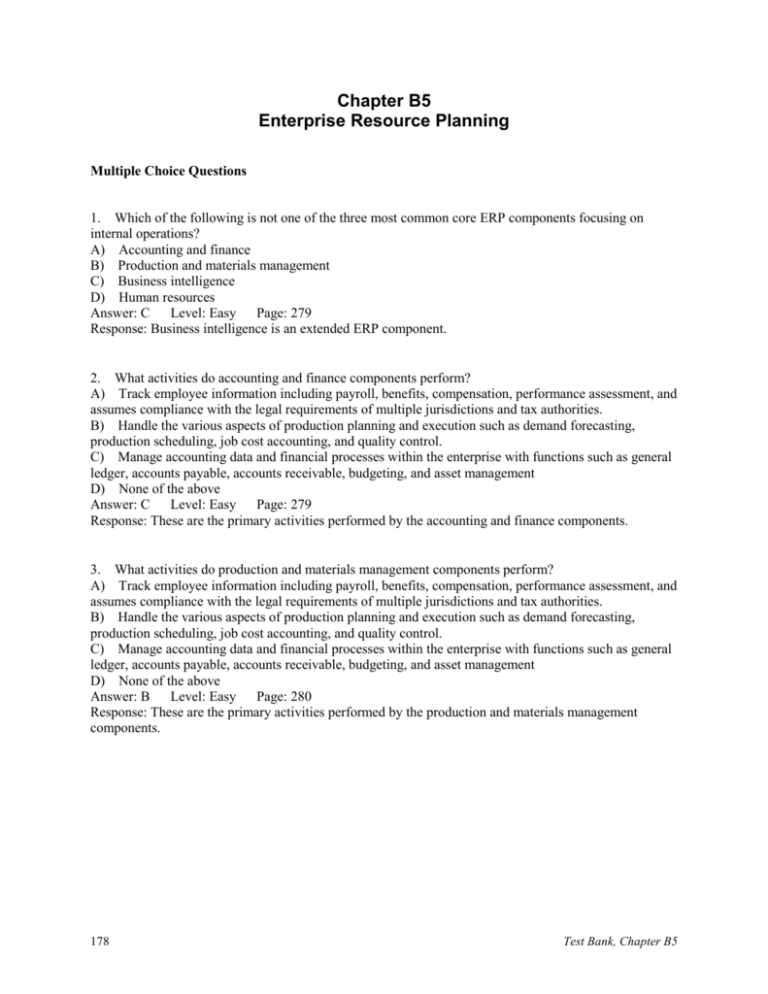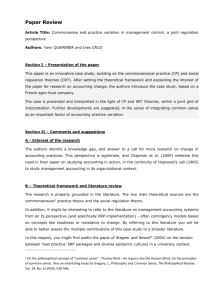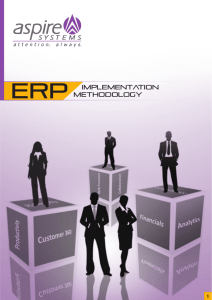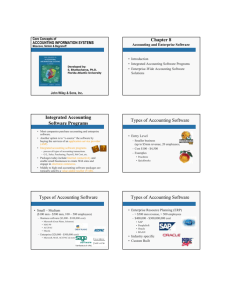BPI005 - Cal Poly College of Business
advertisement

Chapter B5 Enterprise Resource Planning Multiple Choice Questions 1. Which of the following is not one of the three most common core ERP components focusing on internal operations? A) Accounting and finance B) Production and materials management C) Business intelligence D) Human resources Answer: C Level: Easy Page: 279 Response: Business intelligence is an extended ERP component. 2. What activities do accounting and finance components perform? A) Track employee information including payroll, benefits, compensation, performance assessment, and assumes compliance with the legal requirements of multiple jurisdictions and tax authorities. B) Handle the various aspects of production planning and execution such as demand forecasting, production scheduling, job cost accounting, and quality control. C) Manage accounting data and financial processes within the enterprise with functions such as general ledger, accounts payable, accounts receivable, budgeting, and asset management D) None of the above Answer: C Level: Easy Page: 279 Response: These are the primary activities performed by the accounting and finance components. 3. What activities do production and materials management components perform? A) Track employee information including payroll, benefits, compensation, performance assessment, and assumes compliance with the legal requirements of multiple jurisdictions and tax authorities. B) Handle the various aspects of production planning and execution such as demand forecasting, production scheduling, job cost accounting, and quality control. C) Manage accounting data and financial processes within the enterprise with functions such as general ledger, accounts payable, accounts receivable, budgeting, and asset management D) None of the above Answer: B Level: Easy Page: 280 Response: These are the primary activities performed by the production and materials management components. 178 Test Bank, Chapter B5 4. What activities do human resource components perform? A) Track employee information including payroll, benefits, compensation, performance assessment, and assumes compliance with the legal requirements of multiple jurisdictions and tax authorities. B) Handle the various aspects of production planning and execution such as demand forecasting, production scheduling, job cost accounting, and quality control. C) Manage accounting data and financial processes within the enterprise with functions such as general ledger, accounts payable, accounts receivable, budgeting, and asset management D) None of the above Answer: A Level: Easy Page: 281 Response: These are the primary activities performed by the human resource components. 5. Which component is a credit-management feature typically included? A) Accounting and finance components B) Production and managerial management components C) Human resource components D) Production and materials management components Answer: A Level: Easy Page: 279 Response: One of the best features of an accounting and finance component is its credit management feature. 6. Which component can help an organization determine such things as the identification of individuals who are likely to leave the company unless additional compensation or benefits are provided? A) Accounting and finance components B) Production and managerial management components C) Human resource components D) Production and materials management components Answer: C Level: Easy Page: 281 Response: These activities are performed by the human resource component. 7. Which of the following is an extended ERP components? A) Business intelligence B) E-business C) Customer relationship management D) None of the above Answer: D Level: Easy Page: 281 Response: All of the above are included in extended ERP. 8. Which extended ERP component collects information used throughout an organization, organizes it, and applies analytical tools to assist managers with decisions? A) Business intelligence B) E-business C) Customer relationship management D) Supply chain management Answer: A Level: Easy Page: 281 Response: These are the primary activities performed by business intelligence. Haag et al., Business Driven Technology 179 9. What are two of the primary features of e-business components? A) E-procurement B) E-logistics C) All of the above D) None of the above Answer: C Level: Easy Page: 282 Response: E-logistics and e-procurement are both included in the e-business component. 10. Which channels do ERP vendors need to build for access into the ERP systems? A) One channel for customers (B2B) B) One channel for suppliers C) One channel for partners D) All of the above Answer: D Level: Easy Page: 282 Response: An ERP vendor must build access for all of the above. 11. According to Meta Group, what is the average time it takes for the average company to see results from an ERP solution? A) 6 to 12 months B) 8 to 18 months C) 6 to 16 months D) Impossible to determine Answer: B Level: Medium Page: 282 Response: According to Meta Group, it can take anywhere from 8 to 18 months to see ERP benefits. 12. According to Meta Group, what is the average savings from a successful ERP implementation? A) $500,000 B) $1.6 million C) $5 million D) Impossible to determine Answer: B Level: Medium Page: 282 Response: According to Meta Group, average cost savings are $1.6 million. 13. Which of the following is a primary risk associated with an ERP implementation? A) Quality B) Lost information C) Cost D) Employee turnover Answer: C Level: Medium Page: 283 Response: Cost is the biggest risk of an ERP implementation. 180 Test Bank, Chapter B5 14. Which of the following is a common ERP benefit? A) Integrate financial information B) Standardize and speed up manufacturing processes C) Reduce inventory D) All of the above Answer: D Level: Easy Page: 282 Response: All of the above are common ERP benefits. 15. Which of the following is not a common ERP benefit? A) Standardize manufacturing processes B) Speed up manufacturing processes C) Standardize human resource information D) Speed up human resources Answer: D Level: Easy Page: 282 Response: ERPs do not speed up human resources, ERPs have no control over human resources. 16. Which of the following is an associated ERP cost? A) Purchasing the software B) Hiring external experts to help implement the system correctly C) Redefining processes D) All of the above Answer: D Level: Easy Page: 282 Response: All of the above are ERP costs. 17. Which of the following is not an associated ERP cost? A) Customization B) Integration and testing C) Reduce inventory D) Data conversion Answer: C Level: Medium Page: 282 Response: Reducing inventory is not a cost. 18. Which of the following is not one of the three biggest vendors in the ERP market? A) SAP B) Oracle C) PeopleSoft D) Microsoft Answer: D Level: Easy Page: 284 Response: Microsoft is not a major ERP vendor. Haag et al., Business Driven Technology 181 19. What does an ERP vendors future success depend on? A) Its ability to incorporate Internet, e-business, and wireless technology B) Its ability to incorporate Internet, interface, and wireless technology C) Its ability to incorporate Interface, e-business, and wireless technology D) None of the above Answer: B Level: Easy Page: 285 Response: An ERP must incorporate the Internet, interface, and wireless technology if it wants to stay competitive in the future. 20. What is the single most important force reshaping the architecture and functionality of ERP systems? A) Internet B) Interface C) Wireless technology D) E-business Answer: A Level: Medium Page: 285 Response: The Internet is the greatest force reshaping ERP. 182 Test Bank, Chapter B5









